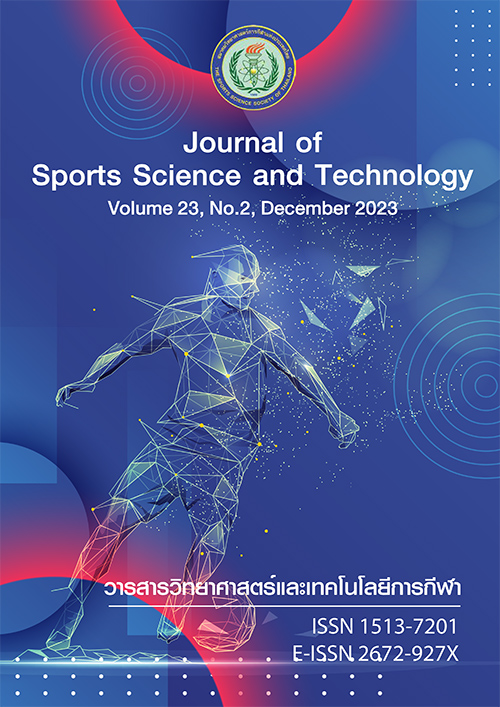ANTHROPOMETRY ON KINEMATICS AND TEMPORAL VARIABLES DURING BUTTERFLY TO BACKSTROKE TURNING IN THAI NATIONAL SWIMMERS: A PRELIMINARY STUDY
Keywords:
Turning performance, Anthropometry, Center of mass, Time on the wall, Push-off velocityAbstract
The purpose of this study is to investigate the anthropometry using the Ape index on push-off velocity, time on the wall, and center of mass trajectory in the vertical direction during the butterfly to backstroke turning. The study involved 8 Thai national swimmers, with an average age of 19.3 ± 4.4 years, weight of 64.2 ± 9.8 kilograms, and height of 173 ± 7.9 centimeters. Anthropometric measurements were taken, including weight height, and arm span. The participants were then divided into two groups based on their arm span-to-height ratio, with one group having an Ape index greater than 1 (Arm Span/Height >1) and the other group having an Ape index less than 1 (Arm Span/Height <1). Before starting the experiment, the participants in both groups were attached to the reflective marker on the Sacrum, then performed butterfly to backstroke turning for 3 trials. 20 cameras of 3-dimensional twin motion capture system were used to record. For statistical analysis, the Independence t-test was used to find the difference in biomechanical variables between two groups. The significant level was set at p-value < 0.05
The research found no significant difference in push-off velocity, time on the wall between the two groups (p-value> 0.05). Furthermore, when comparing the center of mass trajectory in the vertical direction, both groups had similar patterns. However, the reasons for these findings need to be clarified as other factors may be affecting the transition, such as individual turning techniques. In conclusion, body proportions using the Ape index did not affect time on the wall, push-off velocity, and center of mass trajectory in the vertical direction during the butterfly to backstroke turning for the swimmers in both groups.
(Journal of Sports Science and Technology 2023; 23(2):8-19)
(Received: 14 April 2023, Revised: 13 July 2023, Accepted: 17 July 2023)
* Corresponding Author: Taspol KEERASOMBOON
College of Sports Science and Technology, Mahidol University,THAILAND
Email: taspol_spmed@yahoo.com
References
Mullen JG. Swimming Science: Optimum performance in the water: Ivy Press; 2018.
Arellano Colomina R, Sánchez Molina JA, Navarro Valdivieso F, Morales Ortiz E, López Contreras G. Swimming Science I. 2007.
Maglischo EW. Swimming fastest: Human kinetics; 2003.
Barbosa TM, Bragada JA, Reis VM, Marinho DA, Carvalho C, Silva AJ. Energetics and biomechanics as determining factors of swimming performance: updating the state of the art. J Sci Med Sport. 2010;13(2):262-9.
Barbosa TM, Marinho DA, Costa MJ, Silva AJJBia. Biomechanics of competitive swimming strokes. 2011:367-88.
Born DP, Romann M, Stöggl T. Start Fast, Swim Faster, Turn Fastest: Section Analyses and Normative Data for Individual Medley. J Sports Sci Med. 2022;21(2):233-44.
Martens J, Figueiredo P, Daly D. Electromyography in the four competitive swimming strokes: A systematic review. J Electromyogr Kinesiol. 2015;25(2):273-91.
Jürimäe J, Haljaste K, Cicchella A, Lätt E, Purge P, Leppik A, et al. Analysis of swimming performance from physical, physiological, and biomechanical parameters in young swimmers. Pediatr Exerc Sci. 2007;19(1):70-81.
Chainok P, Machado L, de Jesus K, Abraldes JA, Borgonovo-Santos M, Fernandes RJ, et al. Backstroke to Breaststroke Turning Performance in Age-Group Swimmers: Hydrodynamic Characteristics and Pull-Out Strategy. Int J Environ Res Public Health. 2021;18(4).
Slawson S, Conway P, Justham L, Le Sage T, West A. Dynamic signature for tumble turn performance in swimming. Procedia Eng. 2010;2(2):3391-6.
Chakravorti N, Slawson SE, Cossor J, Conway PP, West AA. Swimming Turn Technique Optimisation by Real-Time Measurement of Foot Pressure and Position. Procedia Eng. 2012;34:586-91.
Blanksby B, Gathercole DG, Marshall RN. Force plate and video analysis of the tumble turn by age-group swimmers. J Swim Res. 1996;11(Fall):40-5.
Puel F, Morlier J, Avalos M, Mesnard M, Cid M, Hellard P. 3D kinematic and dynamic analysis of the front crawl tumble turn in elite male swimmers. J Biomech. 2012;45(3):510-5.
Blanksby B, Simpson J, Elliott B, McElroy K. Biomechanical Factors Influencing Breaststroke Turns by Age-Group Swimmers. J Appl Biomech.1998;14:180-9.
Araujo L, Pereira S, Gatti R, Freitas E, Jacomel G, Roesler H, et al. Analysis of the lateral push-off in the freestyle flip turn. J Sports Sci. 2010;28(11):1175-81.
Nicol E, Ball K, Tor E. The biomechanics of freestyle and butterfly turn technique in elite swimmers. Sports Biomech. 2019.
Lätt E, Jürimäe J, Mäestu J, Purge P, Rämson R, Haljaste K, et al. Physiological, biomechanical and anthropometrical predictors of sprint swimming performance in adolescent swimmers. J Sports Sci Med. 2010;9(3):398-404.
Alves M, Carvalho DD, Fernandes RJ, Vilas-Boas JP. How Anthropometrics of Young and Adolescent Swimmers Influence Stroking Parameters and Performance? A Systematic Review. Int J Environ Res Public Health. 2022;19(5).
Lavoie JM, Montpetit RR. Applied physiology of swimming. Sports Med (Auckland, NZ). 1986;3(3):165-89.
Şenel Ö, Baykal C. The relationship between stroke-rate, stroke-length and some anthropometric features in 11 - 12 year old swimmers11 – 12 yaş yüzücülerde kulaç oranı ve kulaç uzunluğunun bazı antropometrik özelliklerle ilişkisi. J Hum Sci. 2017;14:4077.
Alves M, Carvalho DD, Fernandes RJ, Vilas-Boas JP. How anthropometrics of young and adolescent swimmers influence stroking parameters and performance? A systematic review. Int J Environ Res Public Health. 2022 Feb 22;19(5):2543






